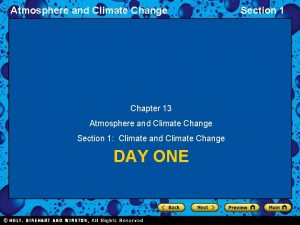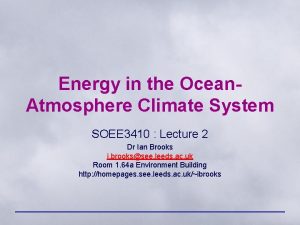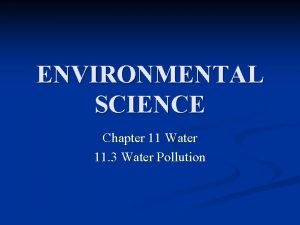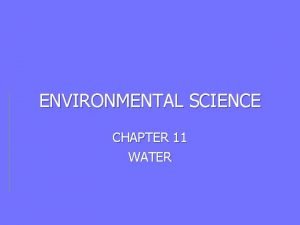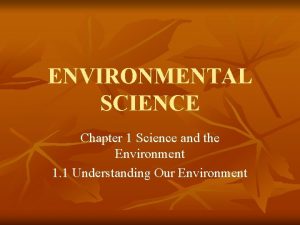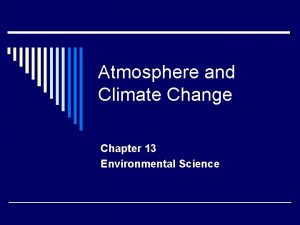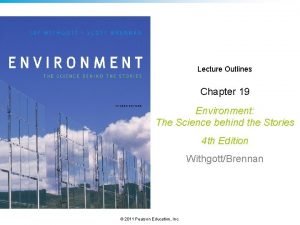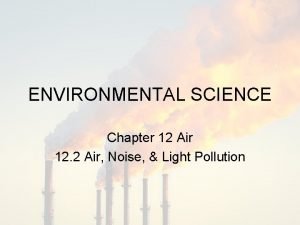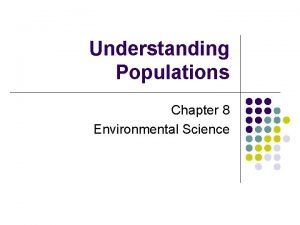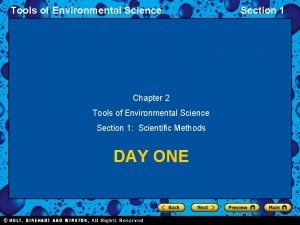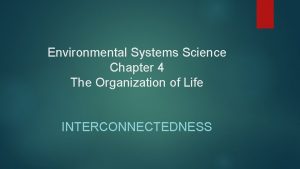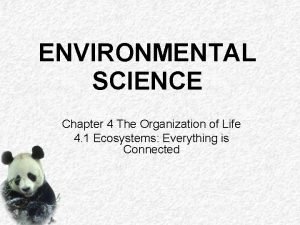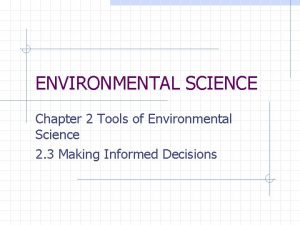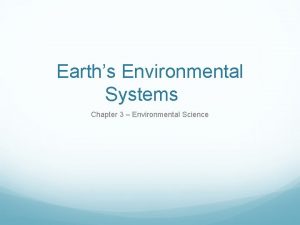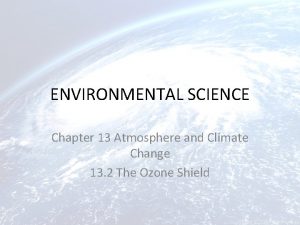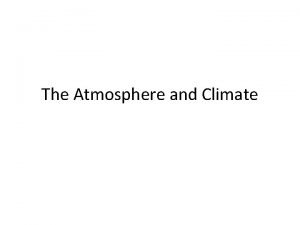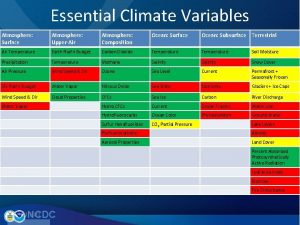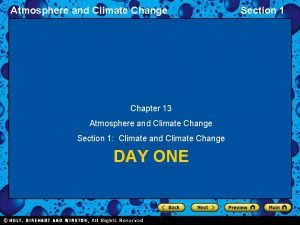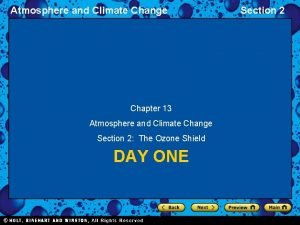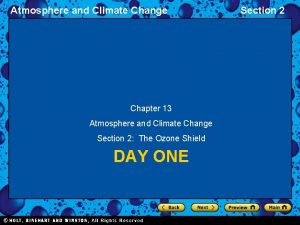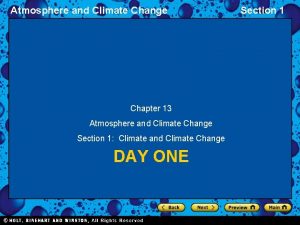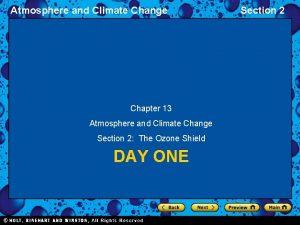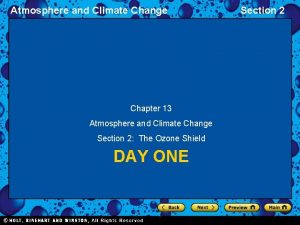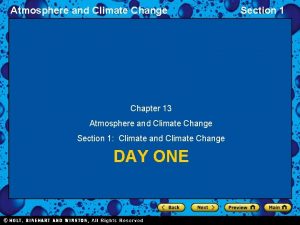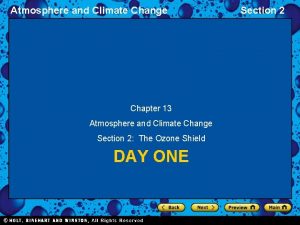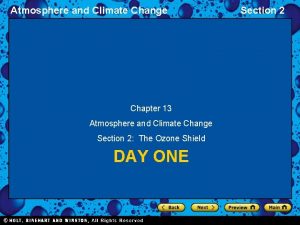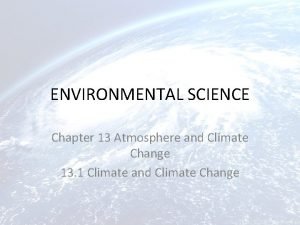Atmosphere and Climate Change Chapter 13 Environmental Science























- Slides: 23

Atmosphere and Climate Change Chapter 13 Environmental Science

Climate o Weather – state of atmosphere at certain time o Climate – long term conditions of atmosphere o Factors determining climate n Latitude p p p Distance from the equator – north or south Low latitudes n Night and day are the same length n Temps high all year round High latitudes n The sun is lower in the sky – less energy from sun n Hours of daylight and temperature vary throughout the year

What Factors Determine Climate? o Atmospheric Circulation n How wind is created p The sun heats the ground and the air above it p The warm air rises p Cooler air moves in to replace it o Global Circulation Patterns n Near the equator p Hot air pushes the cold air north or south p Cold air sinks the further north or south it goes (less hot air present)

What Factors Determine Climate? o Prevailing Winds n Winds that blow mostly 1 direction during the year p Blow to the right in the Northern Hemisphere p Blow to the left in the Southern Hemisphere n Trade Winds p Prevailing winds between 30° north and south n Westerlies p Prevailing winds between 30° and 60° north and south n Polar Easterlies p Prevailing winds between the poles and 60° north and south latitude

Oceanic Circulation Patterns o Ocean current movement n Winds & Earth’s rotation o El Niño (warm phase) n Short-term change in location of warm and cold water masses in the Pacific Ocean n More rainfall in the Southern US n Drought in Indonesia and Australia o La Niña (cold phase) n Opposite of El Niño o Pacific Decadal Oscillation (PDO)

Topography o Elevation affects the climate n n Height above sea level Higher up you go, the colder it is o Mountain ranges affect the precipitation n n Rain on the west side of a mountain Dry on the east side of a mountain o Seasonal changes due to tilt of the Earth

Other Influences o Sun n The more sun, the more UV radiation n The more UV rays, the more ozone n The more ozone, the warmer the air o Volcanoes n Sulfur dioxide gas gets into the upper atmosphere n Reacts with water vapor and dust n Forms a layer of haze which blocks sun n Can cause a decrease in the global temp.

Assignment o Page 334 o Section 1 Review o #1 -4, 6

The Ozone Shield o Ozone Layer n Area in the stratosphere where ozone is highly concentrated p Ozone n is made of three oxygen molecules Absorbs most UV light from the sun p UV light can damage genetic material & cause skin cancer n n Acts as a sunscreen for people Ozone hole p Found in 1979 and is a thin layer of ozone

Chemicals That Deplete the Ozone Layer o Chlorofluorocarbons (CFCs) n n Nonpoisonous, nonflammable Used in refrigerator and air conditioner coolants Used as propellant in spray cans (paint, etc) When these chemicals get into the stratosphere, they break apart, absorb UV radiation and destroy ozone

How Does the Ozone Hole Form? o In Antarctica during the winter, winds of cold air surround the warm air o The air becomes very cold o Clouds with water and nitric acid form n Polar Stratospheric Clouds o CFCs are converted to chlorine o In the spring, when the UV rays touch the chlorine, it splits and destroys ozone o The destruction causes the ozone hole to form

Can ozone replace itself? o Ozone can be produced on the Earth’s surface as air pollution o This ozone breaks down in the troposphere n Therefore the ozone never reaches the stratosphere o So, the answer is no. Ozone can not replace itself.

Effects of Ozone Thinning on Animals and Plants o UV light can kill phytoplankton n n This could disrupt the ocean food chains This could increase the amount of carbon dioxide in the atmosphere o Damage to amphibian eggs o Interferes with photosynthesis in plants n Can lower crop yields

Protecting the Ozone Layer o In 1987, Canadian group met n Agreed to use less CFCs o In 1992, a conference in Denmark n Countries agreed to eliminate CFCs by 2000 n Companies developed CFC replacements p No more aerosol cans o Problem - CFC molecules remain in stratosphere for 60 – 120 years

Assignment o Page 338 o Section 2 Review o # 1 -5

Global Warming o The Greenhouse Effect n n Sunlight goes through the atmosphere Heats the Earth’s surface p Some of the heat escapes into space p The rest of the heat is absorbed by gases o Greenhouse Gases n n n Water vapor Carbon dioxide Chlorofluorocarbons Methane Nitrous oxide

Carbon Dioxide o Measuring the levels in the atmosphere n Summer p Levels n are low due to photosynthesis Winter p Levels are high due to dying grasses and fallen leaves releasing carbon into the air o Most released greenhouse gas n n n Power plants Cars Burning of rain forests for farmland

How certain is global warming? o Global warming n n Predicted increase in global temperature Scientists are unable to accurately predict the rate of global warming p Too n many variables involved They try to predict by using computer models p They enter a large amount of data

Consequences of Global Warming o Melting ice and rising sea levels n n n Erodes the beaches Coastal homes could be lost Coastal aquifers will become too salty o Global weather patterns would change n Warmer Earth means warmer oceans p Increase n in hurricanes More rain in areas – flooding problems

Consequences of Global Warming o Human Health Problems n More heat-related deaths n More respiratory problems n Insect-borne diseases could spread o Agriculture n More droughts would occur o Effects on Plants and Animals n Could change the types of plant species n Animals may change where they live

Recent Findings o Intergovernmental Panel on Climate Change (IPCC) – published report p Surface temp increased by 0. 6°C in 20 th century p Predicts that human activity will make the temp and gases levels increase in 21 st century o Kyoto Protocol n Developed countries are to reduce emissions of carbon dioxide and other gases by 5 percent by 2012 n Most developed countries agreed, US did not o Reforestation projects n Reduces carbon dioxide levels

Assignment o Section 3 Review o Page 345 o # 1 -4, 6

Chapter 13 Review o Pages 347 -349 o # 6 -21, 24 -27, 33 o #36 – Write a paragraph to adequately answer this question.
 Climate change 2014 mitigation of climate change
Climate change 2014 mitigation of climate change Atmosphere
Atmosphere Chapter 13 atmosphere and climate change
Chapter 13 atmosphere and climate change Ocean smallest to largest
Ocean smallest to largest Ocean atmosphere and climate
Ocean atmosphere and climate Tragedy of the commons
Tragedy of the commons Climate change meaning and definition
Climate change meaning and definition Science is my favorite subject because
Science is my favorite subject because Objective of water pollution
Objective of water pollution Is water that contains waste from homes or industry
Is water that contains waste from homes or industry Environmental science chapter 1
Environmental science chapter 1 Environmental science chapter 13
Environmental science chapter 13 Chapter 19 environmental science
Chapter 19 environmental science Chapter 2 economics and environmental policy
Chapter 2 economics and environmental policy Radonrid
Radonrid Environmental science chapter 8 review answer key
Environmental science chapter 8 review answer key Chapter 2 tools of environmental science
Chapter 2 tools of environmental science Chapter 4 environmental science
Chapter 4 environmental science Chapter 4 the organization of life
Chapter 4 the organization of life Chapter 2 environmental science
Chapter 2 environmental science Earth's environmental systems chapter 3
Earth's environmental systems chapter 3 Chapter 10 biodiversity
Chapter 10 biodiversity Chapter 9 environmental science
Chapter 9 environmental science Chapter 13 environmental science
Chapter 13 environmental science


